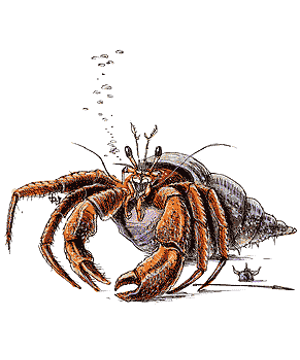

2140

| Giant Crab | Giant Crayfish | |
|---|---|---|
| Climate/Terrain: | Any seashore | Temperate/Freshwater rivers |
| Frequency: | Rare | Uncommon |
| Organization: | None | None |
| Activity Cycle: | Any | Any |
| Diet: | Omnivore | Omnivore |
| Intelligence: | Non- (0) | Non- (0) |
| Treasure: | Nil | Nil |
| Alignment: | Neutral | Neutral |
| No. Appearing: | 2-12 | 1-4 |
| Armor Class: | 3 | 4 |
| Movement: | 9 | 6, Sw 12 |
| Hit Dice: | 3 | 4+4 |
| THAC0: | 17 | 15 |
| No. of Attacks: | 2 | 2 |
| Damage/Attack: | 2-8/2-8 | 2-12/2-12 |
| Special Attacks: | Nil | Nil |
| Special Defenses: | Surprise | Surprise |
| Magic Resistance: | Nil | Nil |
| Size: | L (8-15�) | L (8�+ long) |
| Morale: | Elite (13) | Elite (13) |
| XP Value: | 65 | 175 |
Giant crustaceans are peculiar mutations of crabs and freshwater crayfish. The first inhabits saltwater regions, while the latter is found only in fresh water.
Giant crabs look just like regular crabs except for their enormous size. They come in a variety of colors, such as reds, browns, and grays. They have eyes set on stalks, which enable them to see around corners and onto ledges. Their bodies are covered by a large, chitinous shell. Crabs are distinguished by their scuttling, sideways mode of locomotion.
Combat: Always hungry, crabs prefer to sneak up upon their prey (-3 penalty to opponent�s surprise roll) and catch it in their pincers, dismembering and eating it. A successful attack by the pincers causes 2d4 points of damage. Once they have caught something edible, they stop to eat it, unless they are attacked. If a crab finds its meal in question, it attempts to scuttle off with the prize, perhaps to its den.
Habitat/Society: The giant crab lives on the shoreline, searching beaches for food and venturing into the water in search of fish and other aquatic life. It is well adapted to this sort of life, since it is able to breathe both air and water. Giant crabs frequently feed on large dead fish and other carrion washed up on the shore. They operate equally well on land and in the water. Giant crabs sometimes burrow into the sand during the day, emerging only at dusk and dawn to feed. At these times the beach is alive not only with the giant crabs, but with their tiny cousins as well. The giants may also hunt during the day and night.
The crab exists only on the most basic instinctive level, and is interested solely in survival. Crabs mate in the autumn and males attempt to mate with as many females as they can. Females bury their eggs in the sand. The eggs hatch the following spring; few hatchlings survive to reach maturity. Nature has forced the giant crabs to become flexible eaters, always willing to try new food sources.
Ecology: The giant crab performs a useful ecological function in keeping the seashores free of large carrion that would otherwise rot. On the shore, it is hunted by the ultimate predators � humans and demihumans � for its superb meat and hard chitinous shell, which is prized by some for making armor and shields.
The crayfish is essentially a freshwater lobster. It has a similar multi-plated shell, numerous legs, eyes set on stalks, and two wicked pincers. The giant crayfish is muddy brown or sand colored, depending upon the color of the river bottom it inhabits. Some say that the giant crayfish, like the lobster, keeps growing as it gets older; certain sages even argue that the giant crayfish is really the same species as the ordinary crayfish, merely an extremely old specimen.
Combat: Like the crab, the crayfish prefers to ambush its prey (-2 penalty to opponent�s surprise roll). It sits quietly on the river bottom, waiting, and then rushes forth to seize its food in its pincers. The giant crayfish does not normally represent a danger to adventurers, since it inhabits only deep rivers and spends all of its time on the river bottom. It would therefore only attack adventurers who were swimming along the river bottom, and then only if they came within its range. An attack by a giant crayfish�s pincers inflicts 2d6 points of damage. The crayfish prefers to drag its catch back to its watery lair and eat in peace. Its shell is very tough, giving the creature AC 4.
Habitat/Society: The giant crayfish inhabits only wide and deep rivers, and feeds almost exclusively upon bottom-dwelling fish. Due to its great size, it can easily prey on such fish as sturgeon, carp, and large eels. It is voracious and spends most of its time hunting. On the whole it rarely crosses paths with adventurers, but it does compete with river fishermen.
Ecology: The giant crayfish is considered a delicacy by other creatures, which perhaps accounts for its rarity. Nixies especially prize the meat of the giant crayfish. Dragon turtles, giant snapping turtles, merrows, giant otters, gar, giant pike, and storm giants are just some of the monsters that hunt the giant crayfish. It is very far from being the top predator in its food chain, and must fight for its survival.
Last Modified: March 19, 2010, 15:30:46 GMT

◆ 345 ◆